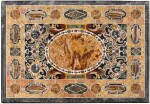
KILLADOON HOUSE, PROPERTY FROM AN IMPORTANT IRISH ESTATE
AN ITALIAN PIETRE TENERE AND PIETRA DURA TABLE TOP, ROME EARLY 17TH CENTURY
Auction Closed
January 21, 06:17 PM GMT
Estimate
40,000 - 60,000 GBP
Lot Details
Description
KILLADOON HOUSE, PROPERTY FROM AN IMPORTANT IRISH ESTATE
AN ITALIAN PIETRE TENERE AND PIETRA DURA TABLE TOP, ROME EARLY 17TH CENTURY
the rectangular moulded top inlaid with alabaster in the centre, the surroundings with hardstone-inlaid scrolls and strapwork, the outer border with alternating band of roundels and horizontal tablets inlaid with various hardstones against Spanish brocatello
141cm. wide, 97cm. deep; 4ft. 7½in., 3ft. 2¼in.
According to 1836 inventory, acquired by Nathaniel Clements, 2nd Earl of Leitrim, KP PC (Ire) (1768-1854) when in Rome in 1820
Inventory, April 1830, 'One Inlaid Marble Table' in the Entrance Hall;
Inventory, 27th June 1836, 'Inlaid marble table of the finest marbles upon marble brackets sculptured by Steward in Dublin. The table was bought at Rome by Lord Leitrim in 1820' in the Entrance Hall
COMPARATIVE LITERATURE
S. Jervis and D. Dodd, Roman Splendour and English Arcadia: The English taste for pietre dure and the Sixtus Cabinet at Stourhead, London, 2015.
A. M. Giusti, Pietre Dure, Hardstone in Furniture and Decorations, London, 1992.
The present table top showcases the natural beauty of stones and embodies the triumph of Rome from the early 16th century as a centre for pietre dure. The archaeological discoveries of the time as well the lasting passion for marbles and rare stones, so significant since Imperial Rome, lends the table a connection with Antiquity and most specifically to the splendour of the Eternal city where the tradition of skilled marble-working had survived.
The technique of pietre dure results in the neat and painstaking arrangement of finely cut hardstones inset on a ground of white marble. This table is distinctively Roman, namely for its subtle blend of geometrical and abstract motifs. Such geometry is noticeable, for example, in design dated from circa 1565 by the Italian Giovanni Antonio Dosio (see Jervis, p.48, fig. 52) and on several table tops, one in Aston Hall (ill. Jervis, p. 5, fig.4), one sold Sotheby's London, 7 December 2010, lot 22 (£163,250) one sold Sotheby's London, Treasures, 3 July 2013, lot 10 (£962,500).
The area surrounding the typical large roundel of alabaster in the centre of a Roman table top is often decorated with a border with small geometric shapes and then abstract motifs such as scrolls and strapwork. Related examples are the Museo del Prado (ill. Jervis, p.25, fig. 10) and one dated from the early 17th century at Hatfield House, Hertfordshire (ill. Jervis, p. 6, fig. 5).
